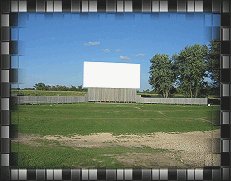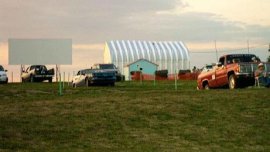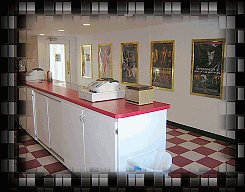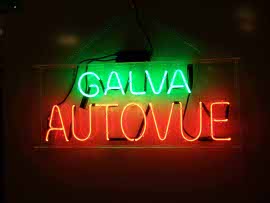 America's first drive-in theatre - which was also the world's first drive-in theatre - opened on June 6, 1933, and the act of watching movies from one's car proved so enduringly popular that now, 75 years later, hundreds of drive-ins can be found in locations all across the country.
America's first drive-in theatre - which was also the world's first drive-in theatre - opened on June 6, 1933, and the act of watching movies from one's car proved so enduringly popular that now, 75 years later, hundreds of drive-ins can be found in locations all across the country.
Then again, there used to be thousands.
"I grew up in Peoria," says Justin West, owner of the Autovue Drive-in Theatre in Galva, Illinois, "and we had, as I remember, five drive-ins within a reasonable radius of Peoria. When I was in high school, the drive-in was the hangout. So I was kind of spoiled. I just figured that they'd be there forever. And then one day I came back from school, and they were all gone."
And not just from Peoria. "The Quad Cities, at one time, had five operating drive-ins," recalls Dennis Voy, owner and manager of Maquoketa, Iowa, radio station WMAQ, and owner of the city's 61 Drive-in. "And that was a lot. I mean, there were towns like Des Moines that only had two or three, and Cedar Rapids had maybe two or three, but to have five was really something.
"So you might say that the Quad Cities have been a drive-in community since 1950," he adds. "It's had a lot of drive-in fans."
It's hard to be a drive-in community, though, in a community without a drive-in, and since the 1987 closing of Davenport's Oasis - which followed the closings of Davenport's Bel Air, Moline's Corral, Milan's Memri, and Silvis' Semri - drive-ins have been missing even from areas surrounding the Quad Cities. If you visit Drive-Ins.com and search for operational outdoor theatres within a 30-mile radius of Davenport and Rock Island, you'll find a grand total of zero.
Of course, the gradual disappearance of drive-ins is by no means a strictly local phenomenon. A report by the United Drive-In Theatre Owners Association shows that at outdoor theatres' peak in 1958, the United States boasted 4,063 operational drive-ins, and by 2007, that number had dwindled to 383. (A state-by-state breakdown of theatres and locations is available at UDITOA.org/media.html.)
Yet drive-ins continue to be built (West opened his Autovue on July 1, 2005), and longtime drive-ins continue to draw customers (Voy's 61 Drive-in opened in August of 1950 and, impressively, has stayed open for 58 years), and the reason appears simple: Drive-ins may have gone away, but drive-in fans haven't.
"I think a lot of my customers remember their mother and dad going with them to the drive-in," says Voy, "and now these people want to bring their kids."
A Good Deal
 The drive-in of today doesn't look a whole lot different from the drive-in of yesterday, the model for which was originally conceived by in the early 1930s by Richard Hollingshead Jr. A sales manager for New Jersey's Whiz Auto Products Company, Hollingshead performed lines-of-sight and sound experiments by mounting a projector on the hood of his car, aiming the projector's image at a screen nailed between two trees, and positioning a radio behind the screen.
The drive-in of today doesn't look a whole lot different from the drive-in of yesterday, the model for which was originally conceived by in the early 1930s by Richard Hollingshead Jr. A sales manager for New Jersey's Whiz Auto Products Company, Hollingshead performed lines-of-sight and sound experiments by mounting a projector on the hood of his car, aiming the projector's image at a screen nailed between two trees, and positioning a radio behind the screen.
On May 16, 1933, Hollingshead was granted a patent on his idea, and three days after that, he began construction on Camden, New Jersey's simply named "Drive-in Theatre."
Less than three weeks after that (and at a cost of roughly $30,000), the country's first drive-in theatre was operational, offering the entertainment bargain of 25 cents for the car, 25 cents per person, and no patrons asked to pay more than $1 total.
"Drive-ins were always considered a good deal," says West. "And the same thing for the price of the concessions. You could bring the whole family and get to enjoy two movies for less than the price of one, typically, at an indoor theatre."
By the end of the 1930s, the country had 18 operating drive-ins in 11 states, and following the post-World War II Baby Boom when more and more families were seeking low-priced entertainment, drive-in-theatre construction increased exponentially. (As did the construction of drive-in playgrounds, designed to keep kids entertained, and frequenting the concession stand, before the features began.) 1946 saw the number of outdoor theatres increase from 102 to 155, which then increased to 820 by 1948, which then increased to 3,775 by 1954.
Four years later, there were more than 4,000 outdoor theatres nationwide. But as drive-ins began catering to a teen and young-adult audience in the early 1960s - the demographic that had grown up on drive-in movies - the family audience began to seek entertainment options elsewhere, and many theatres closed; the number of drive-ins dropped by 17 percent from its peak in 1958 to 1967.
It was over the next 20 years, though, that a number of forces combined to make outdoor theatres seem not just passé but downright irrelevant. By 1987, there were fewer than 1,000 American drive-ins still in operation.
 Economic forces, says Voy, were certainly a factor: "A big problem that happened with drive-ins, both locally and nationwide, was that a lot of them were on the edge of town, and as the town grew, their eight or 10 or 15 acres became so valuable that the owners of the drive-ins couldn't turn down an offer for the land." Developers, he says, began "to build Wal-Marts and Targets and that sort of thing. So the land on the edge of the community, and the drive-ins, closed to make way for something else."
Economic forces, says Voy, were certainly a factor: "A big problem that happened with drive-ins, both locally and nationwide, was that a lot of them were on the edge of town, and as the town grew, their eight or 10 or 15 acres became so valuable that the owners of the drive-ins couldn't turn down an offer for the land." Developers, he says, began "to build Wal-Marts and Targets and that sort of thing. So the land on the edge of the community, and the drive-ins, closed to make way for something else."
Voy - who assumed ownership of the 61 Drive-in 1972 - says that the Maquoketa theatre, however, wasn't in such danger. "In my area, we're in the middle of a cornfield, and so that was never the case. Nobody ever approached me because of the land."
Yet beyond landscape changes, the films that drive-ins had traditionally screened were changing, too. Outdoor theatres began experiencing more difficulty in securing first-run features, as a good deal for a family of five isn't necessarily a good deal for the studios earning a percentage of the ticket price. Consequently, many drive-ins began favoring low-budget B movies - "drive-in movies" - that had considerably less popular appeal. (Lots of cult appeal, though.)
And matters weren't helped by burgeoning home-video market. "The '80s was when the rent-your-own-movie thing started," says Voy. "VHS tapes became very popular in the early '80s and right through the '80s, so that really hurt theatre business, when people were able to take home a brand-new movie and watch it on their TV for a couple bucks."
"Families started moving away" from drive-ins, says West. "There was cable TV, and other avenues of entertainment, and drive-ins started losing their family audience. They turned to porn films in some of these cases, and were able to keep an audience going. But then came the VCR, and video porn, and that killed that business."
It also, in many respects, killed drive-ins' collective reputation. "There's always this stigma - and it's well outdated from days gone by - that there'll be porn movies on it," says West of some continued attitudes about drive-in fare. "Or that it'll be a bad hangout for kids; that they'll be messin' around in the back seats of cars, and all that stuff."
(When searching for a drive-in locale prior to settling in Galva, West says, "I'd actually come in contact with some towns that were not sure about having a drive-in location in their area. In fact, I remember one county where the zoning guy even said, 'You know, we haven't had a drive-in here in 20 years!' As if that's something positive.")
Even Voy's developer-free zone felt the crunch. "There were some real lean years back in the '80s," he recalls, "when it was almost impossible to keep it running. But KMAQ kicked in a little bit to help keep it going, and it was still making a few dollars, and I knew the people enjoyed it, and it was a fun business that I enjoyed, so I just kept it open."
Hope for the Best
 After another national tumble, in which the number of operational drive-ins fell to 447 by 1999, the number appears to have held more or less steady; there were only 60 fewer outdoor theatres in 2007 than there were in 2000. Yet that's still a loss of nearly 15 percent of 2000's remaining drive-ins, and while Voy concedes that "it is true there are a few new theatres being built around the country now," he adds: "There are still some that are going out of business; there was one that went out of business in Council Bluffs just last year, here in Iowa."
After another national tumble, in which the number of operational drive-ins fell to 447 by 1999, the number appears to have held more or less steady; there were only 60 fewer outdoor theatres in 2007 than there were in 2000. Yet that's still a loss of nearly 15 percent of 2000's remaining drive-ins, and while Voy concedes that "it is true there are a few new theatres being built around the country now," he adds: "There are still some that are going out of business; there was one that went out of business in Council Bluffs just last year, here in Iowa."
Voy adds that even in its best years, a drive-in is never an assured business proposition. "A drive-in can have a good year or a bad year just depending on the quality of the movies and the good weather or bad weather," he says. "We have some good weekends and we have some very bad weekends, so it's always a gamble-type business. You just have to hope for the best." (And you really have to hope that the movies are ones your patrons want to see; unlike at the multiplex, audiences can't choose from a dozen-plus options at the drive-in.)
And the drive-in is an even more uncertain business in an uncertain economic climate. West says, "I've had a lot of things that have doubled in price just this year. Popcorn has doubled in price, my nacho chips have doubled in price, shipping costs ... . A lot of other things have gone up 10, 15, 50 percent. Everything's gone up."
Including, of course, the price of getting to the drive-in. "I can say that gas prices are having a negative effect on attendance, for people traveling a good distance," West says. "People are definitely weighing the cost of the gas being used before they decide to come out."
Yet come out they still do, in part because drive-ins are finding less difficulty in securing first-run releases; now that studios routinely open Hollywood releases on upwards of 3,000 screens, renting them to the few hundred outdoor theatres remaining isn't the potential drain on profits it once was.
And also in part because, perhaps consequently, outdoor theatres appear to be reclaiming some of the family audiences that long avoided drive-ins.
"Over the last 10 years, I have switched to a more family-type operation," says Voy, adding that his Maquoketa drive-in sees as many as 350 cars on a Saturday night "when there's good weather and a good movie.
 "We play a lot of family films, and we have a swing set and a sandbox and a kiddie train that gives rides, and volleyball, and all that sort of thing going on before the show starts. And it's a good way for a family to go, because they see two movies for $6.50, the little kids [age 4 and under] are free, the other kids are just two and a half dollars. They can come early, they can bring their own food if they like, and do some tailgating until the movie starts ... .
"We play a lot of family films, and we have a swing set and a sandbox and a kiddie train that gives rides, and volleyball, and all that sort of thing going on before the show starts. And it's a good way for a family to go, because they see two movies for $6.50, the little kids [age 4 and under] are free, the other kids are just two and a half dollars. They can come early, they can bring their own food if they like, and do some tailgating until the movie starts ... .
"It's an economical way to have four or five hours of fun as a family," says Voy. "I think the 61 Drive-in will be open for another 50 years."
And despite this industry's financial hardships, West's Autovue Drive-in continues to draw audiences, and has found particular fans in younger audiences. "I give out a glow bracelet to every kiddie who comes in," he says. "It makes it easier to see them when they're walking around in the lot at night, and it's become kind of a big thing here. I tell 'em at the box office, 'Don't forget, kids, you get a free glow bracelet,' and they say, 'Oh yeah, we know, we know!'" He laughs. "They can't wait for 'em!"
Besides, adds West, money isn't - or at least shouldn't be - anyone's primary goal in opening a drive-in theatre.
"It's not a business to get into to get rich quick," he says. "If it were, then you'd still have plenty of drive-ins out there. You know, it's been around, and tested, and improved upon over the years, but it's not a moneymaker. It pays for itself and that's about it.
"But I grew up in a generation that enjoyed drive-ins. I remember, as a family, going to the drive-ins. It's really a love of it that keeps you doing it, is the way I look at it. And keeping a way of life going, I guess."
For more information on, and show schedules at, the Galva Autovue Drive-in Theatre and Maquoketa's 61 Drive-in Theatre, visit GalvaAutovue.com and Maquoketa.com/61drivein.










